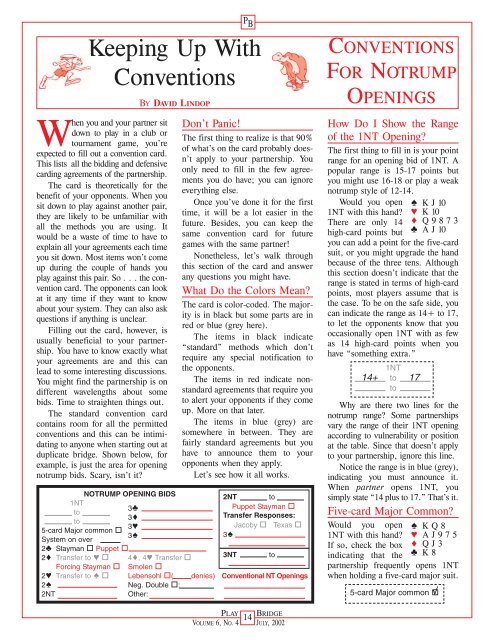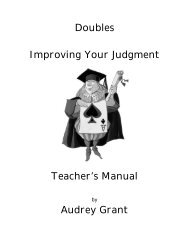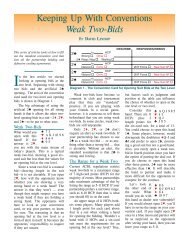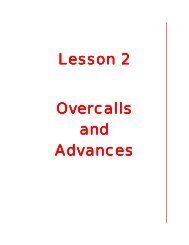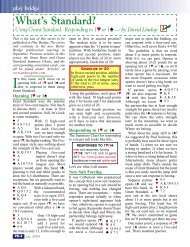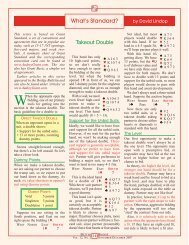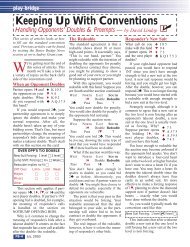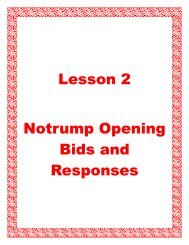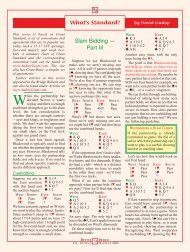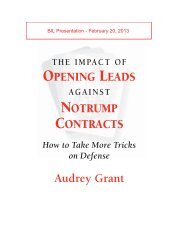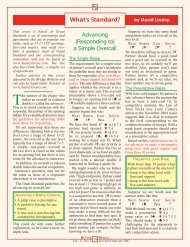NoTrump Openings - Better Bridge
NoTrump Openings - Better Bridge
NoTrump Openings - Better Bridge
Create successful ePaper yourself
Turn your PDF publications into a flip-book with our unique Google optimized e-Paper software.
BY DAVID LINDOP<br />
P B<br />
Keeping Up With<br />
Conventions<br />
When you and your partner sit<br />
down to play in a club or<br />
tournament game, you’re<br />
expected to fill out a convention card.<br />
This lists all the bidding and defensive<br />
carding agreements of the partnership.<br />
The card is theoretically for the<br />
benefit of your opponents. When you<br />
sit down to play against another pair,<br />
they are likely to be unfamiliar with<br />
all the methods you are using. It<br />
would be a waste of time to have to<br />
explain all your agreements each time<br />
you sit down. Most items won’t come<br />
up during the couple of hands you<br />
play against this pair. So . . . the convention<br />
card. The opponents can look<br />
at it any time if they want to know<br />
about your system. They can also ask<br />
questions if anything is unclear.<br />
Filling out the card, however, is<br />
usually beneficial to your partnership.<br />
You have to know exactly what<br />
your agreements are and this can<br />
lead to some interesting discussions.<br />
You might find the partnership is on<br />
different wavelengths about some<br />
bids. Time to straighten things out.<br />
The standard convention card<br />
contains room for all the permitted<br />
conventions and this can be intimidating<br />
to anyone when starting out at<br />
duplicate bridge. Shown below, for<br />
example, is just the area for opening<br />
notrump bids. Scary, isn’t it<br />
Don’t Panic!<br />
The first thing to realize is that 90%<br />
of what’s on the card probably doesn’t<br />
apply to your partnership. You<br />
only need to fill in the few agreements<br />
you do have; you can ignore<br />
everything else.<br />
Once you’ve done it for the first<br />
time, it will be a lot easier in the<br />
future. Besides, you can keep the<br />
same convention card for future<br />
games with the same partner!<br />
Nonetheless, let’s walk through<br />
this section of the card and answer<br />
any questions you might have.<br />
What Do the Colors Mean<br />
The card is color-coded. The majority<br />
is in black but some parts are in<br />
red or blue (grey here).<br />
The items in black indicate<br />
“standard” methods which don’t<br />
require any special notification to<br />
the opponents.<br />
The items in red indicate nonstandard<br />
agreements that require you<br />
to alert your opponents if they come<br />
up. More on that later.<br />
The items in blue (grey) are<br />
somewhere in between. They are<br />
fairly standard agreements but you<br />
have to announce them to your<br />
opponents when they apply.<br />
Let’s see how it all works.<br />
NOTRUMP OPENING BIDS<br />
2NT to<br />
1NT<br />
3<br />
Puppet Stayman <br />
to<br />
3<br />
Transfer Responses:<br />
to<br />
3<br />
Jacoby Texas <br />
5-card Major common <br />
System on over 3<br />
3<br />
2 Stayman Puppet <br />
2 Transfer to 4, 4 Transfer 3NT to<br />
Forcing Stayman Smolen <br />
2 Transfer to Lebensohl ( denies) Conventional NT <strong>Openings</strong><br />
2 Neg. Double :<br />
2NT<br />
Other:<br />
CONVENTIONS<br />
FOR NOTRUMP<br />
OPENINGS<br />
How Do I Show the Range<br />
of the 1NT Opening<br />
The first thing to fill in is your point<br />
range for an opening bid of 1NT. A<br />
popular range is 15-17 points but<br />
you might use 16-18 or play a weak<br />
notrump style of 12-14.<br />
Would you open<br />
1NT with this hand<br />
There are only 14<br />
high-card points but<br />
you can add a point for the five-card<br />
suit, or you might upgrade the hand<br />
because of the three tens. Although<br />
this section doesn’t indicate that the<br />
range is stated in terms of high-card<br />
points, most players assume that is<br />
the case. To be on the safe side, you<br />
can indicate the range as 14+ to 17,<br />
to let the opponents know that you<br />
occasionally open 1NT with as few<br />
as 14 high-card points when you<br />
have “something extra.”<br />
Why are there two lines for the<br />
notrump range Some partnerships<br />
vary the range of their 1NT opening<br />
according to vulnerability or position<br />
at the table. Since that doesn’t apply<br />
to your partnership, ignore this line.<br />
Notice the range is in blue (grey),<br />
indicating you must announce it.<br />
When partner<br />
1NT<br />
14+ to 17<br />
to<br />
opens 1NT, you<br />
simply state “14 plus to 17.” That’s it.<br />
Five-card Major Common<br />
Would you open<br />
1NT with this hand<br />
If so, check the box<br />
indicating that the<br />
KJ 10<br />
K 10<br />
Q 9 8 7 3<br />
A J 10<br />
KQ 8<br />
A J 9 7 5<br />
Q J 3<br />
K 8<br />
partnership frequently opens 1NT<br />
when holding a five-card major suit.<br />
5-card Major common √<br />
PLAY<br />
VOLUME 6, NO. 4<br />
14<br />
BRIDGE<br />
JULY, 2002
Stayman Partner<br />
What would you<br />
respond with this<br />
hand if partner opens<br />
1NT<br />
If the answer is 2, the Stayman<br />
convention asking if opener has a<br />
four-card major suit, then check the<br />
appropriate box.<br />
2<br />
This is the first real “convention”<br />
encountered in this section. Notice<br />
that it’s in black. You don’t have to<br />
make any special announcement to<br />
the opponents if partner responds 2<br />
to your opening 1NT bid. Almost<br />
everyone plays Stayman . . . or some<br />
variation of it (that’s what some of<br />
the red items are for). It’s likely the<br />
first convention you learned.<br />
What If We Want to Use<br />
Transfer Bids<br />
If partner opens<br />
1NT, what would<br />
you respond with<br />
this hand<br />
Stayman √<br />
A 8 4 2<br />
K J 7 3<br />
K 7 5<br />
8 4<br />
8 5 2<br />
J 9 7 6 4 2<br />
7<br />
J 6 3<br />
If you would bid 2 as a signoff<br />
bid, telling partner you want to play<br />
partscore in hearts, you don’t need<br />
to mark anything on the card. That’s<br />
a natural response, not a convention.<br />
If you’d pass with this hand, you<br />
don’t have to check any boxes but you<br />
might want to review your bidding<br />
notes! Partner will have a tough time<br />
making 1NT opposite this hand.<br />
If you would respond 2, asking<br />
opener to bid 2, you are using<br />
Jacoby transfer bids. Since the 2<br />
response is artificial, saying nothing<br />
about diamonds, you have to indicate<br />
this on the card by checking the<br />
appropriate boxes for a 2 or a 2<br />
response (as a transfer to spades).<br />
2 Transfer to √<br />
2 Transfer to √<br />
Jacoby transfer bids are popular<br />
among club and tournament players.<br />
That’s why this section is in blue<br />
(grey) and not red. They are<br />
PLAY<br />
VOLUME 6, NO. 4<br />
P B<br />
announceable but not alertable. If<br />
you are playing Jacoby transfer bids<br />
and partner responds 2 to your<br />
opening bid of 1NT, you would verbally<br />
announce “transfer.” The auction<br />
would then continue unless the<br />
player on your right wanted a further<br />
explanation. It’s quite possible that<br />
your opponents have never heard of<br />
transfer bids.<br />
What If the Opponents<br />
Interfere Over 1NT<br />
Suppose you agree to play transfer<br />
bids and partner opens 1NT but the<br />
player on your right 8 6<br />
overcalls 2, what A J 9 8 5 2<br />
would you respond 8 5<br />
with this hand<br />
10 9 5<br />
You can no longer bid 2 to<br />
transfer to hearts but you still want<br />
to compete for partscore. The standard<br />
approach is to respond 2 as a<br />
natural bid. In other words, Jacoby<br />
transfer bids are “off” when an<br />
opponent overcalls and you revert to<br />
natural responses. Since this is standard,<br />
you don’t have to indicate anything<br />
on the convention card.<br />
If you have some other agreement<br />
— such as doubling to show<br />
hearts — you can mark it on the card<br />
but will then have to alert the opponents<br />
when it comes up.<br />
What if the player on your right<br />
doubles partner’s 1NT opening<br />
instead of overcalling Some partnerships<br />
prefer that all conventional<br />
agreements are off after any form of<br />
interference. The double, however,<br />
hasn’t taken up any bidding room,<br />
so many partnerships agree to continue<br />
using conventions such as<br />
Stayman and transfer bids after the<br />
double. If that’s your agreement,<br />
you can indicate it on the card:<br />
System on over<br />
You could write “Double” or<br />
“Dbl” but bridge players like to use<br />
shorthand, especially given the limited<br />
space available on the card. An<br />
“X” indicates double. (It is used the<br />
same way when recording a result.)<br />
15<br />
X<br />
BRIDGE<br />
JULY, 2002<br />
How Can I Play in a Minor<br />
What would you<br />
do with this hand<br />
if partner opens<br />
the bidding 1NT<br />
This is a good hand to discuss<br />
with partner when filling in the convention<br />
card. You want to sign off in<br />
a minor suit. Because a 2 response<br />
is Stayman, not a signoff, you need<br />
an agreement.<br />
Some partnerships agree to start<br />
with 2, which opener will assume<br />
is Stayman. After opener responds,<br />
you rebid 3 to say, “I really wanted<br />
to play in clubs.” Unfortunately,<br />
in other partnerships this sequence<br />
is a slam try in clubs. <strong>Better</strong> get<br />
your methods straight!<br />
A popular approach is to use<br />
extended Jacoby transfers. A<br />
response of 2 asks opener to bid<br />
3. Responder can then pass with<br />
clubs or convert to 3 to play<br />
partscore in diamonds. If your partnership<br />
uses this approach, you have<br />
to indicate it on the convention card.<br />
2<br />
Transfer to 3<br />
2<br />
J 6 5<br />
9 4<br />
Q 9 7 6 5 3 2<br />
In bridge shorthand this might be<br />
written as “→ 3C” but you get the idea.<br />
Notice that this area is underlined<br />
in red, meaning you have to alert this<br />
convention. If partner responds 2<br />
to your 1NT opening, you say<br />
“Alert.” That tells the opponents that<br />
the 2 response has a non-standard<br />
meaning. You don’t say anything else<br />
unless an opponent asks for an<br />
explanation. In which case you<br />
would say, “It asks me to bid 3<br />
which partner can pass or convert to<br />
3 to sign off in diamonds.”<br />
Anything Else<br />
That’s it unless you have some other<br />
specialized responses. A jump to the<br />
three level in a suit, whether it is<br />
weak, invitational, or forcing, is not<br />
conventional provided it actually<br />
shows the suit.<br />
You probably want to fill in your<br />
range for a 2NT opening, likely<br />
20–21, but your done with this part<br />
of the convention card.


